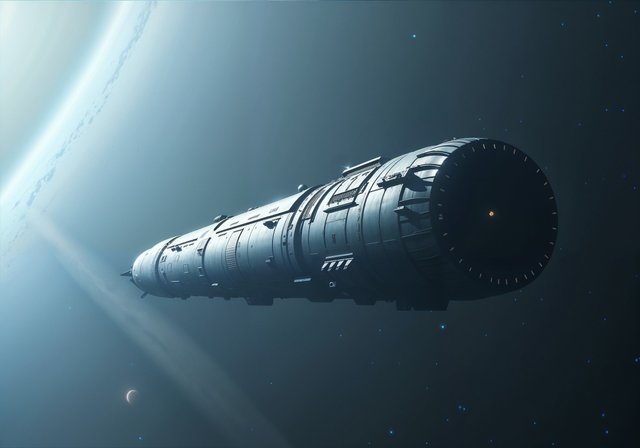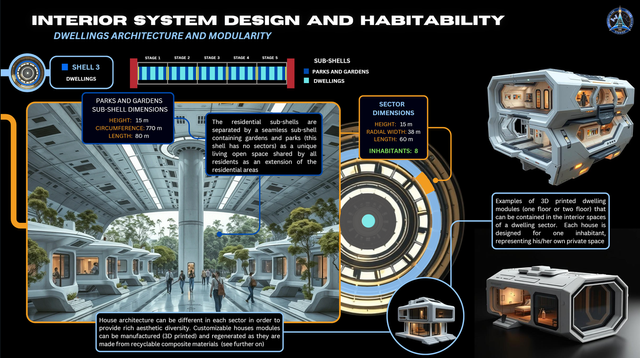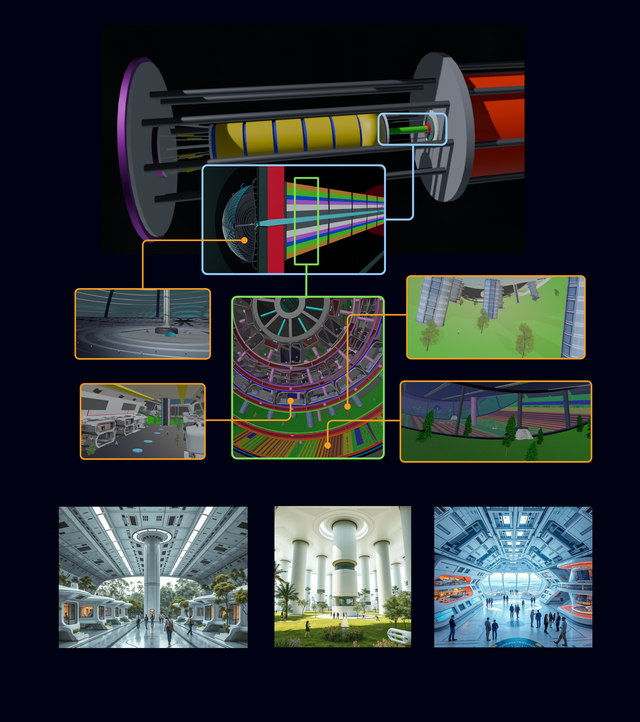Chrysalis, a huge cylinder to colonize other worlds/Chrysalis, un enorme cilindro para colonizar otros mundos

Source
Normally, when we talk about the space race we refer to traveling so alone, literally, to our backyard, the moon, Mars or Saturn's moons are in the parking lot of our urbanization. Even so, the simple fact of putting a foot on the red planet, entails challenges that we still have no idea how to solve. But the universe is inconceivably large and if we want to abandon our solar urbanization, the thing can be complicated only to reach the urbanization closer to ours, Alpha Centauri.
Normalmente, cuando hablamos de la carrera espacial nos referimos a viajar tan solo, literalmente, a nuestro patio trasero, la Luna, Marte o las lunas de Saturno están en el aparcamiento de nuestra urbanización. Aún así, el simple hecho de poner un pie en el planeta rojo, conlleva desafíos que aún no tenemos ni idea de como resolver. Pero el universo es inconcebiblemente grande y si lo que queremos es abandonar nuestra urbanización solar la cosa puede complicarse sobre manera tan solo para llegar a la urbanización más cercana a la nuestra, Alpha Centauri.
Alpha Centauri is the closest star to the sun and is about 4.3 light years away, which means that a "WhatsApp" would take more than four years to arrive. But if we want to get some ship, the thing is further complicated, with the current technology a ship would take about seven thousand years to arrive Alpha Centauri, which does not seem very viable. But we are an adventurous species that has historically demonstrated its eagerness to explore new lands and that is why we are preparing the Chrysalis ship, a huge cylinder to navigate to our neighboring star.
Alpha Centauri es la estrella más cercana al Sol y está a unos 4,3 años luz de distancia, lo que quiere decir que un "whatsapp" tardaría más de cuatro años en llegar. Pero si queremos hacer llegar alguna nave la cosa se complica aún más, con la tecnología actual una nave tardaría cerca de siete mil años en llegar Alpha Centauri, lo que no parece muy viable. Pero somos una especie aventurera que ha demostrado históricamente su afán de explorar nuevas tierras y por eso estamos preparando la nave Chrysalis, un enorme cilindro para navegar hasta nuestra estrella vecina.

Source
Chrysalis is a proposal of the winning generational ship of the Project Hyperion (organized by the Interstellar Studies, I4IS), whose objective is to transport hundreds or thousands of people to another stellar system using plausible technology in the future. It is a cylinder of about fifty -eight kilometers in length with an approximate mass of 2,400 million metric tons, whose mission is to reach the Proxima B planet, more than forty trillion kilometers away from our planet.
Chrysalis es una propuesta de nave generacional ganadora del Project Hyperion (organizado por la Iniciativa para Estudios Interestelares, i4is), cuyo objetivo es transportar a cientos o miles de personas a otro sistema estelar usando tecnología plausible a futuro. Se trata de un cilindro de unos cincuenta y ocho kilómetros de longitud con una masa aproximada de 2.400 millones de toneladas métricas, cuya misión es llegar al planeta Próxima b, a mas de cuarenta billones de km de distancia de nuestro planeta.
The trip would be a few hundred years old, including periods of acceleration and deceleration. To achieve this, the ship would have to reach approximately 1 % of the speed of light or, what is the same, eleven million kilometers per hour. The planned propulsion form for the ship is a direct fusion engine, probably using helium-3 and deuterium. All this implies that we must use a generational ship, capable of sustaining thousands of people during generations.
El viaje levaría unos cuatrocientos años, incluyendo periodos de aceleración y desaceleración. Para lograrlo, la nave tendría que alcanzar aproximadamente el 1 % de la velocidad de la luz o, lo que es lo mismo, once millones de kilómetros por hora. La forma de propulsión planeada para la nave es un motor de fusión directa, probablemente usando helio-3 y deuterio. Todo esto implica que debemos utilizar una nave generacional, capaz de sostener a miles de personas durante generaciones.

Source
Chrysalis functions as a self -sufficient city that rotates to generate artificial gravity. It is organized in multiple concentric layers, with specialized functions. A inner layer closer to the nucleus where crops, biomes (tropical forests, boreals), plants, fungi, animals and insects, an upper layer where community spaces such as parks, libraries, hospitals and classrooms are. A third layer houses the residential area with heated homes and in the outermost layers workshops, factories, recycling and laboratories, warehouses, etc.
Chrysalis funciona como una ciudad autosuficiente que rota para generar gravedad artificial. Está organizada en múltiples capas concéntricas, con funciones especializadas. Una capa interior más cercana al núcleo donde están los cultivos, biomas (bosques tropicales, boreales), plantas, hongos, animales e insectos, una capa superior donde estan los espacios comunitarios como parques, bibliotecas, hospitales y aulas. Una tercera capa alberga la zona residencial con viviendas climatizadas y en las capas mas externas talleres, fábricas, reciclaje y laboratorios, almacenes, etc.
Although Chrysalis could house between 1,500 and 2,400 people, designers consider optimal to maintain about 1,500 habitables to guarantee the sustainability of the system. The number of births would be planned to avoid overpopulation and to govern it, a form of sociocracy is raised, in which decision -making is agreed and assisted by artificial intelligence, to take care of social stability and intergenerational knowledge transfer. As an initial measure, the founding group would live for 70-80 years in isolation in Antarctica to evaluate its psychological adaptation to extreme confinement.
Aunque Chrysalis podría albergar entre 1.500 y 2.400 personas, los diseñadores consideran óptimo mantener unos 1.500 habitables para garantizar la sostenibilidad del sistema. El número de nacimientos se planificaría para evitar sobrepoblación y para gobernarla se plantea una forma de sociocracia, en la que la toma de decisiones es consensuada y asistida por inteligencia artificial, para cuidar la estabilidad social y la transferencia intergeneracional de conocimiento. Como medida inicial, el grupo fundador viviría durante 70-80 años en aislamiento en la Antártida para evaluar su adaptación psicológica al confinamiento extremo.
More information/Más información
https://www.thebrighterside.news/post/chrysalis-starship-could-take-2400-passengers-on-a-400-year-voyage-to-the-planet-proxima-b/